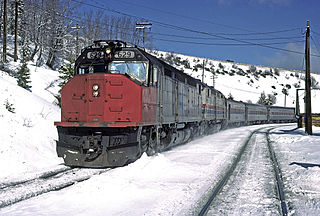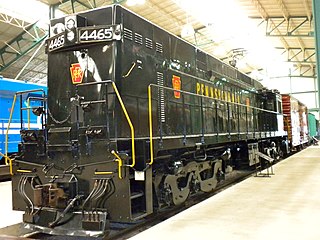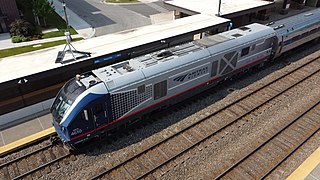
The Maple Leaf is an international passenger train service operated by Amtrak and Via Rail between Pennsylvania Station in New York City and Union Station in Toronto via the Empire Corridor. Daily service is offered in both directions; the 544-mile (875 km) trip takes approximately 12 hours, including two hours for U.S. or Canadian customs and immigration inspection at either Niagara Falls, New York, or Niagara Falls, Ontario. Although the train uses Amtrak rolling stock exclusively, the train is operated by Via Rail crews while in Canada and by Amtrak crews in the United States. Service began in 1981.

The EMD AEM-7 is a twin-cab four-axle 7,000 hp (5.2 MW) B-B electric locomotive built by Electro-Motive Division (EMD) and ASEA between 1978 and 1988. The locomotive is a derivative of the Swedish SJ Rc4 designed for passenger service in the United States. The primary customer was Amtrak, which bought 54 for use on the Northeast Corridor and Keystone Corridor. Two commuter operators, MARC and SEPTA, also purchased locomotives, for a total of 65.

Montreal Locomotive Works (MLW) was a Canadian railway locomotive manufacturer that existed under several names from 1883 to 1985, producing both steam and diesel locomotives. For many years it was a subsidiary of the American Locomotive Company. MLW's headquarters and manufacturing facilities were in Montreal, Quebec.

General Electric Genesis is a series of passenger diesel locomotives produced by GE Transportation, then a subsidiary of General Electric. Between 1992 and 2001, a total of 321 units were built for Amtrak, Metro-North, and Via Rail.

The EMD F40PH is a four-axle 3,000–3,200 hp (2.2–2.4 MW) B-B diesel-electric locomotive built by General Motors Electro-Motive Division in several variants from 1975 to 1992. Intended for use on Amtrak's short-haul passenger routes, it became the backbone of Amtrak's diesel fleet after the failure of the EMD SDP40F. The F40PH also found widespread use on commuter railroads in the United States and with VIA Rail in Canada. Additional F40PH variants were manufactured by Morrison-Knudsen and MotivePower between 1988 and 1998, mostly rebuilt from older locomotives.

Amtrak California is a brand name used by the California Department of Transportation (Caltrans) Division of Rail for three state-supported Amtrak regional rail routes in California – the Capitol Corridor, the Pacific Surfliner, and the San Joaquins – and their associated connecting network of Amtrak Thruway transportation services.

The Bombardier–Alstom HHP-8 is a type of twin-cab electric locomotive manufactured by a consortium of Bombardier Transportation and Alstom for Amtrak and MARC. The locomotive's electrical drive technology is directly derived from the SNCF BB 36000 manufactured by Alstom.

The EMD SDP40F was a six-axle 3,000 hp (2.2 MW) C-C diesel–electric locomotive built by General Motors Electro-Motive Division (EMD) from 1973 to 1974. Based on Santa Fe's EMD FP45, EMD built 150 for Amtrak, the operator of most intercity passenger trains in the United States. Amtrak, a private company but funded by the United States government, had begun operation in 1971 with a fleet of aging diesel locomotives inherited from various private railroads. The SDP40F was the first diesel locomotive built new for Amtrak and for a brief time they formed the backbone of the company's long-distance fleet.

An electro-diesel locomotive is a type of locomotive that can be powered either from an electricity supply or by using the onboard diesel engine. For the most part, these locomotives are built to serve regional, niche markets with a very specific purpose.

Amtrak has used a variety of paint schemes (liveries) on its rolling stock since taking over intercity passenger rail service in the United States in 1971. A series of seven schemes termed Phases, first introduced in 1972, have seen the widest use. Phases primarily use geometric arrangements of red, white, and blue—the national colors of the United States—part of Amtrak's patriotic visual identity.

The ABB ALP-44 was an electric locomotive which was built by Asea Brown Boveri of Sweden between 1989 and 1997 for the New Jersey Transit and SEPTA railway lines.

The GE Dash 8-32BWH, also known as the P32-8BWH, B32-8WH, or P32-8, is a passenger train locomotive used by Amtrak, based on GE's Dash 8 series of freight train locomotives. Built in 1991, they were the first locomotives purchased to replace the veteran EMD F40PH.

The passenger locomotives derivatives of the General Motors EMD GP40 diesel-electric locomotive have been, and continue to be, used by multiple passenger railroads in North America. For passenger service, the locomotives required extra components for providing steam or head-end power (HEP) for heating, lighting and electricity in passenger cars. Most of these passenger locomotives were rebuilt from older freight locomotives, while some were built as brand new models.

The PRR E44 was an electric, rectifier-equipped locomotive built by General Electric for the Pennsylvania Railroad between 1960 and 1963. The PRR used them for freight service on the Northeast Corridor. They continued in service under Penn Central and Conrail until Conrail abandoned its electric operations in the early 1980s. They were then acquired by Amtrak and NJ Transit, where they lived short lives; all were retired by the mid-1980s. One is preserved at the Railroad Museum of Pennsylvania.

The GE P30CH was one of the first brand-new diesel-electric locomotives built for Amtrak by General Electric during Amtrak's early years. The design was based on the GE U30C, but had a cowl carbody like its EMD competitors. Amtrak operated them between 1975 and 1992.

The GE E60 is a family of six-axle 6,000 hp (4.5 MW) C-C electric locomotives made by GE Transportation Systems (GE) between 1972 and 1983. The E60s were produced in several variants for both freight and passenger use in the United States and Mexico. GE designed the locomotive for use on the Black Mesa and Lake Powell Railroad (BM&LP), a dedicated coal-hauling route in Arizona, which began operation in 1973. That same year GE adapted the design for high-speed passenger service on Amtrak's Northeast Corridor. The largest customer was Ferrocarriles Nacionales de México (NdeM), the state-owned railroad in Mexico, which bought 39 for a new electrification project in the early 1980s.

The Alstom PL42AC is a class of four axle B-B diesel-electric locomotive designed by Alstom in association with GM-EMD. 33 were built between 2003 and 2006 for NJ Transit Rail Operations.

The MPI HSP46 is a four-axle AC-traction diesel-electric locomotive for commuter trains, designed and assembled by MotivePower. It meets EPA Tier 3 emissions standards. The launch customer is the Massachusetts Bay Transportation Authority (MBTA), whose first unit entered revenue service in April 2014.

The Siemens Charger is a family of diesel-electric/dual-mode passenger locomotives designed and manufactured by Siemens Mobility for the North American market.




















